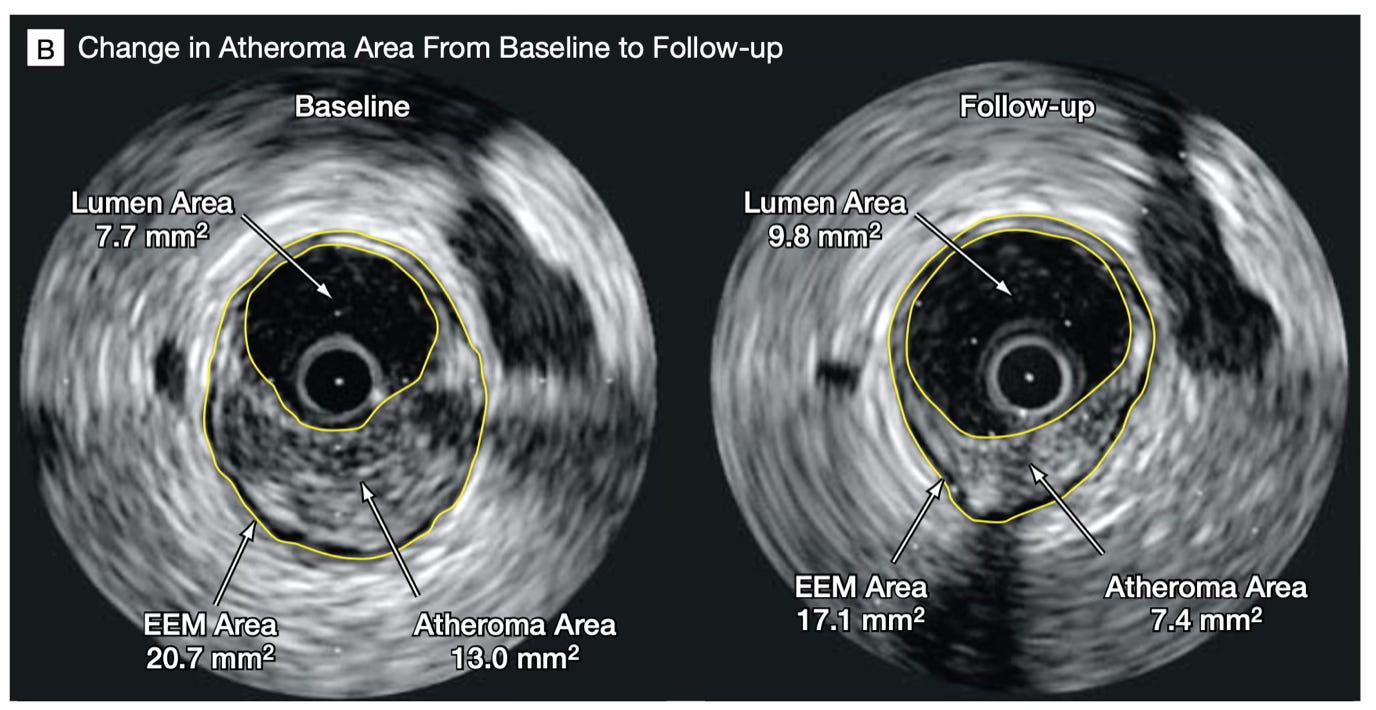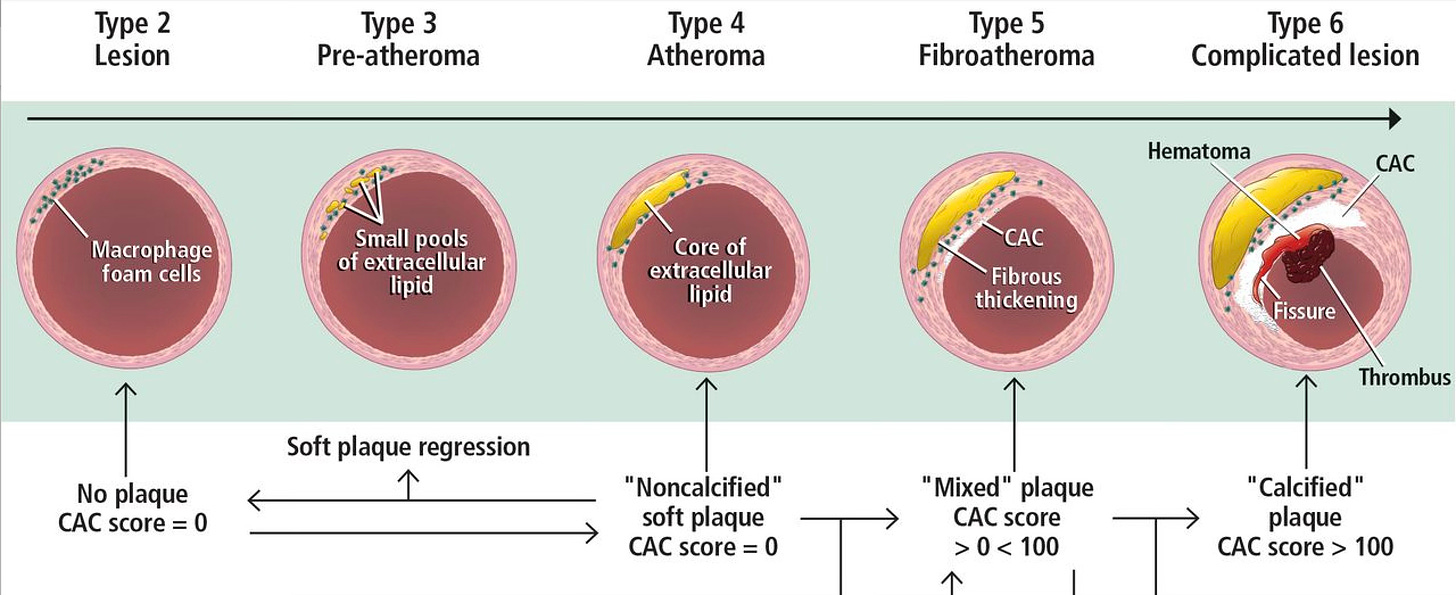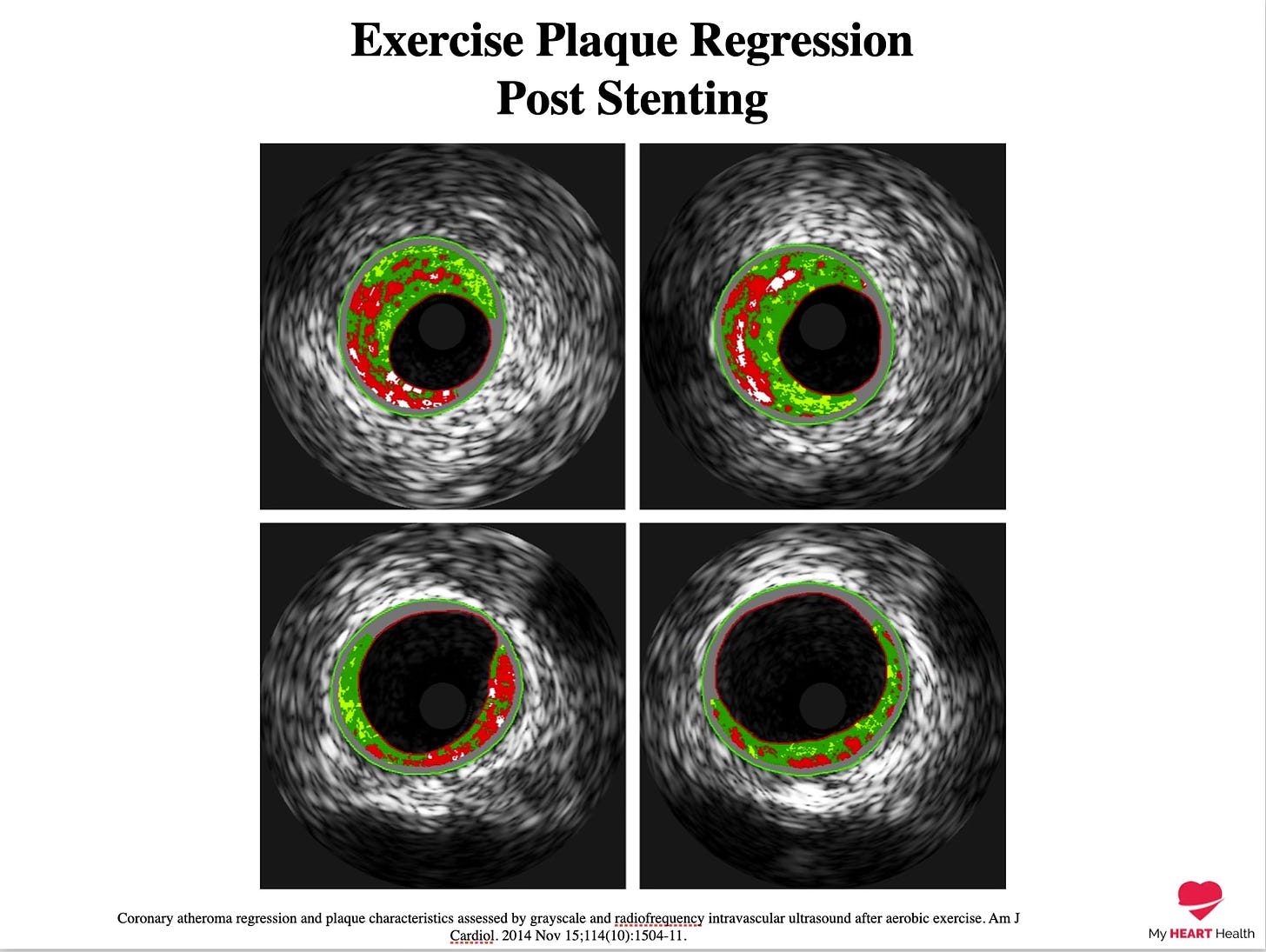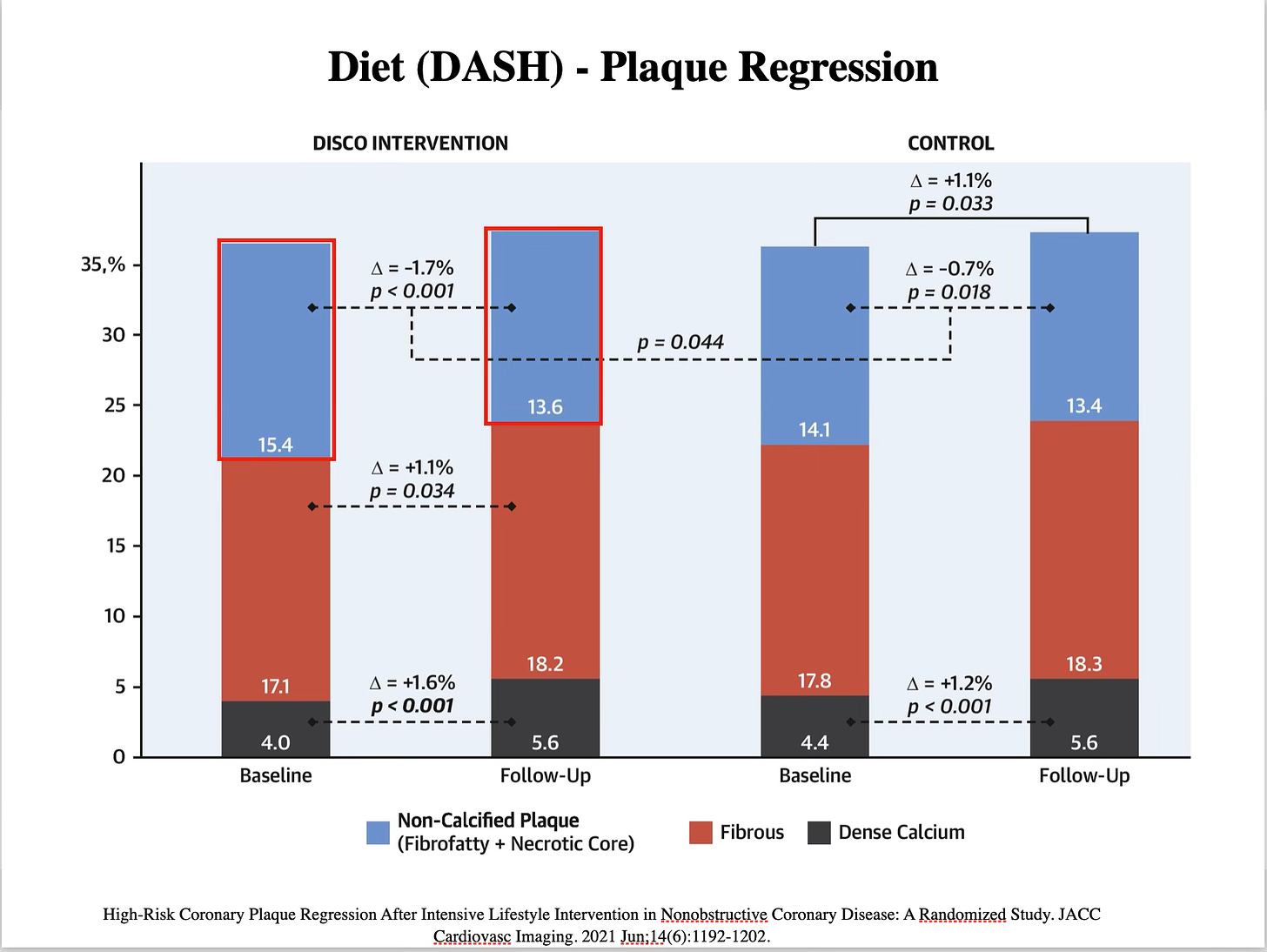How To Reverse Coronary Artery Disease With Lifestyle Measures

Reversing or regressing coronary artery disease is possible.
You cannot eliminate the plaque entirely, but multiple clinical trials have shown plaque regression using high-intensity cholesterol-lowering treatments, which I have discussed previously.
But can coronary artery disease be reversed with lifestyle measures, including changes to nutrition and exercise?
The answer is yes, but the devil is in the detail.
To understand plaque regression, you must understand some key concepts about coronary artery plaque to appreciate the relevance of the studies we will discuss here.
Coronary Atherosclerosis
There are multiple ways of describing coronary plaque:
-
The degree of obstruction
-
The composition of the plaque
-
The thickness of the plaque wall (Cap) that separates the plaque from the inside of the blood vessel.
All of these parameters are important and need to be considered when evaluating plaque regression.
Plaque Size & Obstruction
The degree of obstruction is a key metric as it objectively quantifies the size of a plaque and whether the plaque has decreased in size over time.
One of the primary metrics used in studies of plaque regression is plaque volume or plaque area.

As you would expect, we are always aiming for less plaque (as measured by area or volume), but the composition of the plaque also matters.
Plaque Composition
Depending on the imaging test used to assess the plaque, there are multiple ways of describing plaque makeup.
-
Calcified, Non Calcified, Mixed (A combination of the two)
-
Calcified, Fibrous, Non-Calcifed (Fibrofatty + Necrotic Core plaque)

In general, the more calcified or fibrous a plaque is, the less dangerous it is, as it is less likely to rupture and cause a heart attack.
Fatty or necrotic plaque is often described as ‘vulnerable’ plaque, with the vulnerability being related to the risk of a heart attack.
Cap Thickness
The last component to consider is the thickness of the cap of the plaque that separates the inside of the plaque from the inside of the artery, called the lumen.
In general, the thicker the cap, the better.
Thinner caps are more likely to rupture and cause a heart attack and are described as TCFA’s - Thin Cap Fibroatheromas1.

In summary, the best outcome for plaque is to:
-
Decrease in size
-
Change from non calcified to calcified
-
Develop a thick fibrous cap.
All of these components influence the risk of future heart attacks.
So, now that we understand a bit more about plaque makeup, we can understand how lifestyle factors influence these components.
Exercise
Several studies have assessed the impact of exercise on plaque size and composition.
A recent study looked at the impact of high-intensity interval training on plaque volume over a 6-month time frame.
Patients were randomised to either two weekly sessions of 40 minutes of supervised high-intensity exercise or were just given standard health advice.
After the six months, those in the exercise group had significantly less plaque2.
Plaque atheroma volume had decreased by 1.4% in the exercise group, which may not seem like a lot, but previous studies have shown reductions in major heart events of 20% with similar plaque volume reductions3.
Similar benefits have also been shown with moderate-intensity aerobic exercise.
This emphasises that the real benefit is from exercise in general rather than specific types of exercise4.

The main takeaway here is that exercise regresses plaque size, and for anyone with documented coronary artery disease, it should be a priority, like taking any of your medications.
Nutrition
Poor nutrition and its complications, mostly related to excess visceral fat, significantly increase the risk of future heart events.
The question remains, however, whether improving nutrition can regress or reverse plaque in the coronary arteries.
One of the first studies to address this question was published by Dean Ornish in 1990.
This randomised study investigated whether a multifactorial intervention of a low-fat vegetarian diet in addition to stopping smoking, stress reduction and increased exercise reduced plaque size5.
After one year, the intervention group did have less plaque when compared to the control group.
There were several issues with this trial however.
As you can see above, the intervention was multifactorial, so it is impossible to say whether it was the dietary changes, smoking cessation, or any other interventions that drove this difference.
Secondly, the imaging test used to assess plaque volume was quantitive coronary angiography, which today is considered a far less accurate way to evaluate coronary plaque.
The DISCO trial is a more recent study that attempted to assess the role of nutrition in reversing plaque buildup6.
This randomised trial used the DASH diet as its intervention, which is a primarily plant-based, low fat and lower-sugar diet.
All patients had CT coronary angiograms at the start of the study and repeated after about one year.
There was no increase in overall plaque in the intervention arm, but there was a small increase in the control arm.
The amount of non-calcified plaque was lower in both the intervention and control arms, but the reduction was greater in the intervention arm.
As you will recall from above, we are aiming for less non-calcified or vulnerable plaque, even if it means we get a more calcified plaque.

Smoking
There is no doubt that not smoking or stopping smoking reduces cardiovascular risk. The question is whether smoking impacts the volume or type of plaque in the coronary arteries.
While there are no randomised trials of smoking (Understandably), we know that follow-up studies of those who continue to smoke show a much greater likelihood of having thin cap fibroatheromas.
This means that existing plaque is less likely to develop that thick fibrous cap that seals in a plaque and makes it less likely to cause a heart attack.
Lifestyle Plaque Regression - Kind Of.
One key factor we must consider when evaluating these studies is that all patients in these studies would have been on standard medical therapies, including aspirin, statins and blood pressure meds, IN ADDITION to the lifestyle interventions tested.
Therefore, we cannot view lifestyle measures as a substitute for medical therapies.
This research should support our approach of using BOTH lifestyle and medications to reverse plaque in the coronary arteries.
So, if you have plaque in your coronary arteries, the evidence is clear.
-
Regular exercise decreases plaque volume.
-
Good nutrition (Not just a DASH diet, I suspect) changes plaque composition to safer, more stable plaque.
-
Stopping smoking increases plaque cap thickness and, therefore, stabilises plaque.
Medications are an important part of plaque regression, but if you are not optimising all your lifestyle factors, you are likely leaving benefits on the table.
Pathophysiology of Coronary Artery Disease. In: Yuan, C., Hatsukami, T., Mossa-Basha, M. (eds) Vessel Based Imaging Techniques . Springer, Cham.
High intensity interval training induces beneficial effects on coronary atheromatous plaques – a randomized trial, European Journal of Preventive Cardiology, 2022;, zwac309,
The effects of lipid-lowering therapy on coronary plaque regression: a systematic review and meta-analysis. Sci Rep 11, 7999 (2021).
Coronary atheroma regression and plaque characteristics assessed by grayscale and radiofrequency intravascular ultrasound after aerobic exercise. Am J Cardiol. 2014 Nov 15;114(10):1504-11.
Ornish, D.; Brown, S.E.; Billings, J.H.; Scherwitz, L.W.; Armstrong, W.T.; Ports, T.A.; McLanahan, S.M.; Kirkeeide, R.L.; Gould, K.L.; Brand, R.J. (1990). Can lifestyle changes reverse coronary heart disease?. The Lancet, 336(8708), 129–133. doi:10.1016/0140-6736(90)91656-U
High-Risk Coronary Plaque Regression After Intensive Lifestyle Intervention in Nonobstructive Coronary Disease: A Randomized Study. JACC Cardiovasc Imaging. 2021 Jun;14(6):1192-1202.




